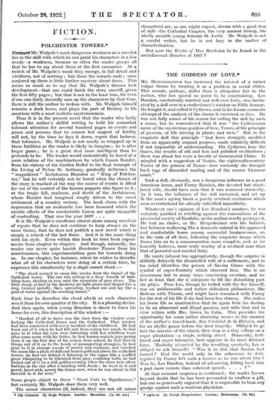FICTION.
POLCHESTER TOWERS.* PEIIHAPirkir. Walpole's most dangerous weakness as a novelist lies in the skill with which he can paint his characters in a few
words—a weakness, because so often the reader grasps all that he has to say about them at the first encounter. At a twitch of Mr. Walpole's wand they emerge, in full detail and vividness, out of nothing ; but there the miracle ends ; once conjured up there is little further mystery about them. This seems as much as to say that Mr. Walpole's themes lack development—that one could finish the story oneself, given the first fifty pages ; but that is not in the least true, for even if one can fairly shrewdly sum up the characters by that time, there is still the author to reckon with. Mr. Walpole himself remains a dark horse, and plays the part of Destiny to his creations with a most realistic mysteriousness.
Thus it is in the present novel that the reader who lazily allows the author's skilful writing to hold his somewhat tolerant attention for several hundred pages to events and issues and persons that he cannot but suspect of futility will not, by the time he lays it down, regret that laziness, that tolerance. Mr. Walpole is not nearly so wrapped up in those futilities as the reader is likely to imagine ; he is after larger game ; he is a great deal more intelligent than he pretends to be. The reader would undoubtedly be bored at a mere relation of the machinations by which Canon Bonder, from his victory of the Garden Roller to his final triumph of the Living of Pybus St. Anthony, gradually dethrones the " magnificent " Archdeacon Brandon as " King of Poiches- ter," but he will certainly not be bored when the climax of the story is reached at the way the course of events is lifted far out of the control of the human puppets who figure in it ; at the tragic fall, madness, and death of the Archdeacon, whom Ronder had imagined simply driven to the sweet retirement of a country rectory. The book closes with the impression that an avalanche has been loosened which the nimble efforts of the comfortable Canon are quite incapable of controlling. That was the year 1897. . .
It is Mr. Walpole's excellence almost alone among novelists of repute that he does not continue to harp always on the same theme, that he does not publish a new novel which is simply a rehash of the last three. And it is the same thing with his style. Even within this book he tries fresh experi- ments from chapter to chapter. And though, naturally, the reader can never quite banish Barchester Towers from his consciousness, this experimentalism goes far towards doing so. In one chapter, for instance, where he wishes to describe what all of his characters were doing at a certain time, he expresses this simultaneity by a single sunset cloud :-
" The cloud seemed to creep like smoke from the funnel of the Cathedral tower. The sun was setting in a fiery wreath of bub- bling haze, shading in rosy mist the mountain of grey stone. The little cloud, at first in the shadowy air light green and shaped like a ring, twisted spirally, then, spreading, washed out and lay like a pool of water against the smoking sunset."
Each time he describes the cloud afresh as each character sees it from his own quarter of the city. It is a pleasing device. And then again, when young Brandon is about to leave his home for ever, this description of the window :— " Hardest of all to leave was the view from the window over- looking the Cathedral Green and the Cathedral. That window had been connected with every incident of his childhood. He had leant out of it when he had felt sick from eating too much, he had gone to it when his eyes were brimming with hot rebellious tears after some scene with his father, he had known ecstatic joys gazing from it on the first day of his return from school, he had thrown things out of it on to the heads of unsuspecting strangers, he had gone to it in strange moods of poetry and romance, and watched the moon like a plate of dull and beaten gold sail above the cathedral towers, he had sat behind it listening to the organ like a muffled giant whispering to be liberated from grey, confining walls, he had looked out of it on a still, golden evening when the stars were silver buttons in the sky after a meeting with Annie ; he went to it and gazed, heart-sick, across the Green now, when he was about to bid farewell to it for ever."
Some people object to these " Short Cuts to Significance,"
but certainly Mr. Walpole does them very well.
The minor characters (if, indeed, they are not all minor
• Teo CathedraL By Hugh Walpole. Landon: Macmillan. [7s. ed. net.)
characters) are, as one might expect, drawn with a good deal of skill—the Cathedral Chapter, the very ancient bishop, the wholly amiable young Johnnie St. Leith. Mr. Walpole is not a careful writer, but he is not lazy in the matter of characterization.
But were the Works of Max Beerbohm to be found in the archidiaconal libraries of 1897 ?










































 Previous page
Previous page